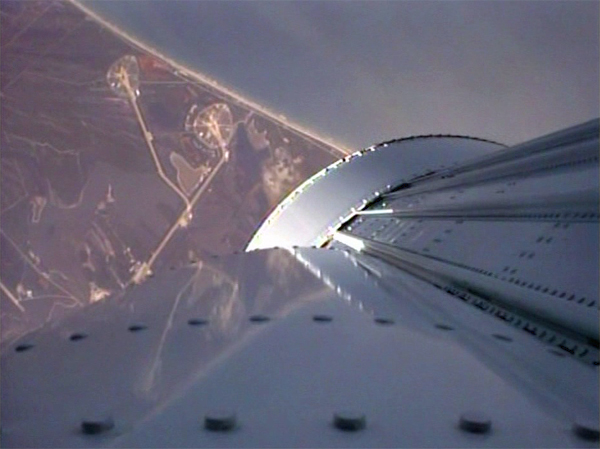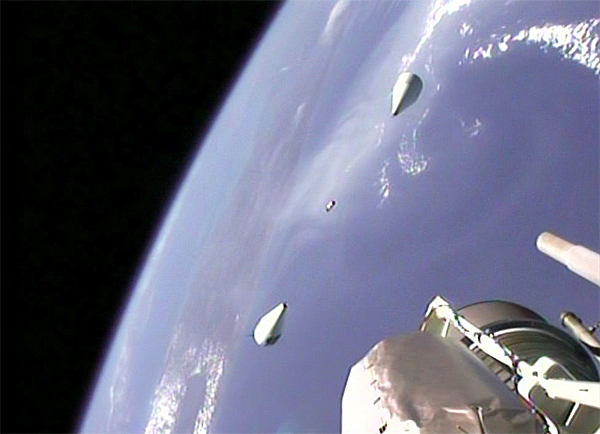Missile warning satellite boosted into space
By WILLIAM HARWOOD
CBS News
Running a day late because of bad weather, a United Launch Alliance Atlas 5 rocket blasted off Saturday and boosted a $1.3 billion missile early warning satellite into space, the first of an expensive new breed of orbital sentries.
The 19-story Atlas 5, carrying the Air Force Space Based Infrared Systems -- SBIRS -- GEO-1 satellite, lifted off from space launch complex 41 at the Cape Canaveral Air Force Station at 2:10 p.m. EDT (GMT-4).
The rocket was not equipped with any solid-fuel boosters, relying instead on the power of its Russian-built dual-nozzle RD-180 first stage engine to climb out of the dense lower atmosphere.
As it arced away to the east over the Atlantic Ocean, a camera mounted on the rocket's second stage beamed down spectacular views of the Florida coast dropping away, including launch pad 39A at the Kennedy Space Center where the shuttle Endeavour is being prepared for flight.
The Atlas 5 first stage performed normally, exhausting its fuel and falling away about four minutes and nine seconds after liftoff.
The Centaur second stage RL10 engine then fired twice to boost the satellite into an elliptical orbit with a high point of some 22,260 miles and a low point of about 115 miles. GEO-1 was released from the second stage 43 minutes after liftoff. Using the satellite's on-board propulsion system, flight controllers plan to carry out six rocket firings over nine days to put the craft in its planned circular orbit 22,300 miles above the equator.
"GEO-1 will provide our nation with significantly improved missile warning capabilities and support a number of other critical missions simultaneously, including missile defense, technical intelligence and battlespace awareness," Brig. Gen. Roger Teague, director of the U.S. Air Force's Infrared Space Systems Directorate, told Spaceflight Now in a pre-launch interview.
Built by Lockheed Martin, GEO-1 is not expected to join the active-duty early warning constellation for 17 months to give engineers time to characterize and calibrate its sensitive infrared sensors and software.
"But that's okay," Teague said. "We're very excited about the possibility of being able to get valuable technical intelligence and battlespace characterization and awareness information off the spacecraft as soon as just a handful of months after launch."
The SBIRS GEO satellites eventually will replace existing Defense Support Program infrared early warning satellites, working in concert with other spacecraft in highly elliptical orbits to provide faster detection of ballistic missile launches and other threats.
CBS News
Running a day late because of bad weather, a United Launch Alliance Atlas 5 rocket blasted off Saturday and boosted a $1.3 billion missile early warning satellite into space, the first of an expensive new breed of orbital sentries.
 |
| A United Launch Alliance Atlas 5 rocket blasts off carrying the $1.3 billion GEO-1 missile early warning satellite. (Credit: ULA) |
The 19-story Atlas 5, carrying the Air Force Space Based Infrared Systems -- SBIRS -- GEO-1 satellite, lifted off from space launch complex 41 at the Cape Canaveral Air Force Station at 2:10 p.m. EDT (GMT-4).
The rocket was not equipped with any solid-fuel boosters, relying instead on the power of its Russian-built dual-nozzle RD-180 first stage engine to climb out of the dense lower atmosphere.
As it arced away to the east over the Atlantic Ocean, a camera mounted on the rocket's second stage beamed down spectacular views of the Florida coast dropping away, including launch pad 39A at the Kennedy Space Center where the shuttle Endeavour is being prepared for flight.
The Atlas 5 first stage performed normally, exhausting its fuel and falling away about four minutes and nine seconds after liftoff.
The Centaur second stage RL10 engine then fired twice to boost the satellite into an elliptical orbit with a high point of some 22,260 miles and a low point of about 115 miles. GEO-1 was released from the second stage 43 minutes after liftoff. Using the satellite's on-board propulsion system, flight controllers plan to carry out six rocket firings over nine days to put the craft in its planned circular orbit 22,300 miles above the equator.
 |
| Shuttle launch pad 39B (left) and 39A (right) are visible in this "rocketcam" view looking down from the climbing Atlas 5 rocket. NASA is readying the shuttle Endeavour for launch from pad 39A later this month.(Credit: ULA) |
 |
| With the Florida peninsula visible in the background, the Atlas 5 first stage can be seen falling away (center) flanked by the two halves of a protective nose cone fairing. The nozzle of the Centaur second stage RL10 engine is visible at bottom right. (Credit: ULA) |
"GEO-1 will provide our nation with significantly improved missile warning capabilities and support a number of other critical missions simultaneously, including missile defense, technical intelligence and battlespace awareness," Brig. Gen. Roger Teague, director of the U.S. Air Force's Infrared Space Systems Directorate, told Spaceflight Now in a pre-launch interview.
Built by Lockheed Martin, GEO-1 is not expected to join the active-duty early warning constellation for 17 months to give engineers time to characterize and calibrate its sensitive infrared sensors and software.
"But that's okay," Teague said. "We're very excited about the possibility of being able to get valuable technical intelligence and battlespace characterization and awareness information off the spacecraft as soon as just a handful of months after launch."
The SBIRS GEO satellites eventually will replace existing Defense Support Program infrared early warning satellites, working in concert with other spacecraft in highly elliptical orbits to provide faster detection of ballistic missile launches and other threats.